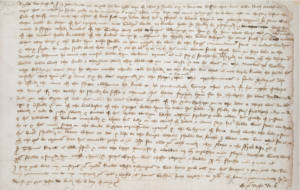Duke of Suffolk William De La Pole
 Childhood
Childhood
William De La Pole was born in October 1396, the son of Michael de la Pole, the 2nd Earl of Suffolk and Katherine De Stafford. It was his elder brother Michael, who inherited the title of 3rd Earl of Suffolk when his father died of dysentery at Harfleur, whilst supporting King Henry V. However, Michaels earldom lasted only a while as he died in the battle of Agincourt, 7 weeks later. As Michael had no sons, the title of Earl of Suffolk was passed to his brother William who was aged 19.
Adulthood
William gradually gained more royal notice and was made a Knight of the Garter in 1421. In 1429 he was captured at Jargeau after the failed siege at Orleans (of Maid of Orleans fame) and was ransomed. In 1430, William married Alice Chaucer, widow of Thomas Montagu and the granddaughter of Geoffrey Chaucer the poet and author.
Rise to Power
William became a member of the royal council from 1431, and from 1435 he actively sought peace in France. One of his main opponents against peace was Humphrey Duke of Gloucester. In 1441, William was one of the commissioners to look at the charges of sorcery against Eleanor Cobham, Humphreys wife at the time, which would not have endeared him to the Duke. When the subject of a royal marriage was discussed, Humphrey pushed for the daughter of the Count of Armagnac, and William was instrumental in defeating the proposition.
Royal Marriage Arrangements
Suffolk was aware that Margaret of Anjou might not be a popular match with some and he managed to get an indemnity, freeing him from all blame, in the coming negotiations. In April 1444, he acted as Henry’s proxy in the betrothal, and oversaw the truce being signed. For his success in arranging the marriage and the truce, he was made Marques of Suffolk in September. Suffolk, escorted the bride to be back to England. From then William became the leading English lord, leaving him to be the target of many accusations from the disenfranchised, in particular, Humphrey, the Kings Uncle.
In Feb 1447, whilst parliament was at Bury St Edmunds, Suffolk arrested Humphrey. Five days later Humphrey died. Whether he was killed or just died due to his age, blame was put at Williams door even though there was no charge aimed at him. The King trusted William and was made a Duke in 1448.
Unpopular
The blame for the loss of Maine and Anjou, in the marriage of Margaret, was aimed at him. But, the King stepped in and issued a proclamation declaring his satisfaction in William. When Maine was handed to the French in 1448, William’s unpopularity rose. When open warfare commenced and Rouen and parts of Normandy were lost, Suffolk’s peace process was finally discredited. As Suffolk had promoted many of his supporters to places of influence, he was accused of pride and avarice.
Downfall
In 1449 William’s influence declined with the resignation of Bishop Marmaduke Lumley (Lord High Treasurer) and Bishop Adam Molyneux (Lord of the Privy Seal) who were staunch supporters of his. When the Lord Cromwell was attacked by William Tailboys, another principal supporter, Cromwell accused Tailboys and William, of intending to murder him.
In January 1450, William made an impressive speech in his defence at parliament, to head off the anticipated attack. But this did not appease the commons and they accused William of selling the realm to the French and treason. William was committed to the Tower. A formal indictment was presented in February. In March several more additional articles including maladministration and malversation, with the promotion of unworthy persons. William denied the charges. King Henry, decided the best course of action was to announce that the case was unproven and he would banish William for 5 years as a compromise, but would ultimately save William’s neck.
Death
On March 19th, Suffolk was released and narrowly escaped the wrath of Londoners, back to Suffolk. On April 30th he left Ipswich on a boat for Burgundy. Whilst off the coast of Dover, his ship was intercepted by another larger ship and he was executed on May 2nd – See story for more details or click here for a contemporary account via the Paston letters.
William was succeeded by his son. William went on to marry Elizabeth of York, the sister of King Edward IV.

